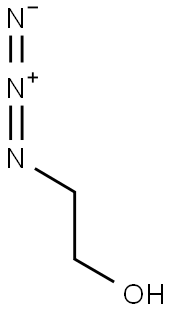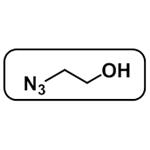Uses
2-Azidoethanol is used as a reagent in the glycosylation of mono- or polysaccharides. 2-Azidoethanol is also used as a 2’-deoxy-ethynyluridine (EdU) blocker in nuclear DNA, preventing cross reactivity with other antibodies in order to better study its related pathways in the body.
Preparation
2-Azidoethanol synthesis: Sodium azide (14.6 g, 224 mmol, 1.5 eq.) was added portion wise to a stirred mixture of 2- chloroethanol (12.0 g, 149 mmol, 1 eq.) in H2O (80 mL) at 0°C. The reaction mixture was slowly warmed up to room temperature and stirred for another 4 h. Additional sodium azide (9.71 g, 149 mmol, 1 eq.) was added and the solution was heated under reflux at 80°C overnight. After completion, the mixture was extracted with Et2O (3×50 mL) and the combined organic phases were washed with Brine (1× 10 mL) and dried over MgSO4. The solvent was removed in vacuo to yield a colorless oil (10.57 g, 121.4 mmol, 81%).
1 H NMR (400 MHz, CDCl3, ppm): δ=3.77 (q, 2H, CH2 OH), 3.43 (t, 2H, CH2 N3), 2.16 (s, 1H, OH). 13C NMR (101 MHz, CDCl3, ppm): δ=61.6 (CH2 OH), 53.7 (CH2 N3). 14N NMR (CDCl3, ppm): δ= 134 (Nβ), 171 (Nγ), 319 (Nα). C2H5N3O (87.08 gmol 1 ) calcd. N 48.25, C 27.59, H 5.79%; found IS: >40 J. FS: >360 N.




